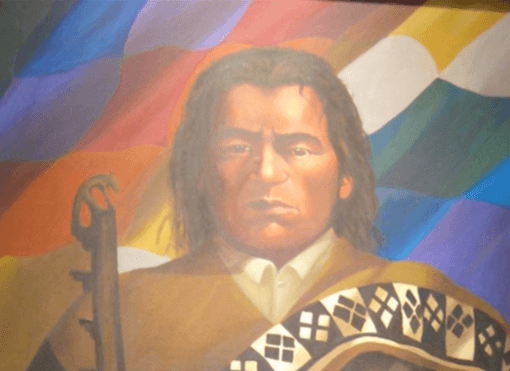Bolivia's Five Hundred-Year Rebellion
DECEMBER 4, 2019
by PETER LACKOWSKI

Photograph Source: Alka Agrawal It appears Gaston Ugangi created the painting – CC0
In 1781, the Bolivian indigenous leader Tupac Katari led a rebellion in which La Paz, the Spanish colonial capital of “Upper Peru,” was besieged for 109 days.The siege ended with the arrival of a Spanish army. Katari was captured, he and his wife, Bartolina Sisa, were gruesomely executed, and thousands of indigenous people were massacred. For many years this was treated as a minor event in history books, but in the latter half of the twentieth century Katari and Sisa have been celebrated as symbols of the resistance to oppression by the indigenous majority, and as martyrs in a national revolution whose time has finally come.
The Five Hundred Year Rebellion: Indigenous Movements and the Decolonization of History in Bolivia, by Benjamin Dangl (AK Press, 2019), is the story of decades of work by organizers, activists, intellectuals, and politicians to turn this story of indigenous resistance to oppression into the symbol of national liberation. It follows the way social movements have related to the question of indigenous identity, and their efforts to organize and focus its power, up to the point of electing an indigenous president. It is a story of decolonization, of people freeing themselves from the mental and political structures that were imposed upon them by imperial powers.
In 1952 the National Revolutionary Movement (MNR) led a revolution that made historic gains with expanded rights for workers, land reform, and national economic sovereignty. It was supported by miners, workers and peasants, but it was led by a white and mestizo middle class who saw the indigenous majority as “primitive,” people who needed to modernized, assimilated, and brought into the economy as workers and capitalist farmers. This implied giving up communal economic forms, traditional clothing, using Spanish, and finding their place in a capitalist society. While peasants welcomed the land reform, cultural change was resisted.
Many indigenous people benefited from improvements in their rights and education, but as their conditions improved they became more aware of how racism was limiting their advancement—it was not just poverty. By the 60’s Aymara, many of rural origin who had got into the university, were forming Katarist circles that promoted a powerful, liberating ideology. In the words Luciano Tapia, a protagonist in the movement, “I understood that, far from feeling as though I were a beggar and foreigner in my own ancestral land, rather, I should instead feel proud of being a descendant of the great and glorious civilizations from this part of the world. From this comes the reason to maintain that beyond being a simple campesino class,we are fundamentally a living historical reality, a people made of flesh and bone, a real Nation.”
More:
https://www.counterpunch.org/2019/12/04/bolivias-five-hundred-year-rebellion/
